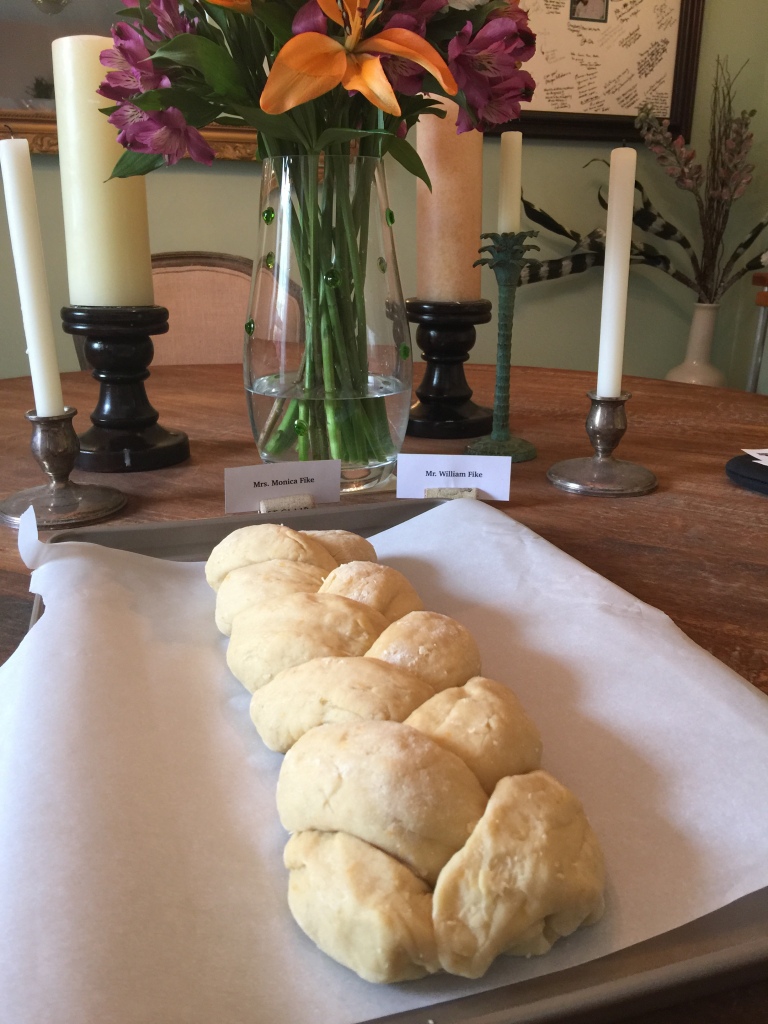For as long as I can remember, my dad’s been making his family’s Italian Easter bread every year for Easter. Your grandmother’s pumpkin or pecan pie: Thanksgiving as my dad’s Easter bread: Easter.
I don’t know why it’s taken me to the ripe age of 36 to attempt to make this bread on my own, but I was recently overcome with a sudden desire to give it a knead. I guess I’ve spent most Easters with my parents so I was never left wanting the bread. This year, my parents are on different coasts and my in-laws are visiting, so what better time to try and carry on this delicious Nista family tradition.
It’s one of my favorite tastes in the world — it’s almost a hybrid between cake and bread — and the orange rind prevents it from being too sweet. My in-laws mentioned it has a creamy texture to it, as well. All I know is it’s unbelievably tasty.
I received the following email from my dad a year ago and gathered everything I needed. He strongly advised I give it a trial run before unveiling this big hunk of bread over a big holiday meal and having it be a flop. We designated last Sunday as cooking day so I made my first attempt then.
My mistake as a newbie was I only let the dough rise for two hours before baking it (per the original recipe instructions). The result didn’t taste bad, but it was extremely dense. My dad informed me after the fact I had to wait for it to grow two times its original size.
Directly from Papa Cosmo:
Here’s the recipe for the closest I can come to my Uncle Gigi Pedoto’s Easter Bread (Uncle Gigi had a bakery so the guy knew his pane):
Italian Easter Bread
- 1 packet active dry yeast
- 4 large eggs
- 1 cup granulated sugar
- 2/3 cup vegetable oil
- 2/3 cup whole milk
- 2 teaspoons Anisette/Sambuca*
- 4 cups all purpose flour (The amount of flour should be the amount needed to create a dough of the right consistency. I have used as many as 6 1/2 cups.)
- 1 teaspoon salt
- 2 tablespoons of grated orange rind
- Confectioners/powdered sugar
- Colored sprinkles
- Dissolve the yeast in 1/4 cup of warm water (check the temperature and make sure it’s roughly at 115 to 120 degrees F). Wait 10 minutes for the yeast to foam.
- In a large bowl, beat the eggs with the sugar until smooth
- Add the vegetable oil, milk, orange rind and anisette and mix well
- Add the yeast mixture and mix well
- Add the salt and gradually add the flour, adding enough flour so you can gather the dough into a ball. The dough should be smooth and not sticky. If the dough is sticky, keep adding flour.
- Knead the dough for 10 minutes
- Let the dough rest for 5 minutes
- Cut the dough into the number of pieces needed for the shape of your choice (I use a three-string braid)
- Roll each piece of dough into a ball, then roll each piece into long strips
- Create your final shape for the bread and place it in a non-stick baking pan (or greased pan or a pan lined with parchment paper). Many traditional versions of this bread garnish the loaf with boiled eggs. We’ve happily skipped this step in our house.
- Place the pan with the shaped dough in a warm area (closed bathroom with lights on works just fine) and cover it lightly and let the dough rise for 2 to 3 hours, keeping care that the cover does not stick to the dough. I dust the surface of the dough with flour before lightly draping a light cotton cloth on top. Uncle Gigi had special wooden boxes that would be stacked to provide a draft free environment for the bread to rise. The key here is to let the dough rise to about twice its original size. It may take longer than 2-3 hours.
- Preheat the oven to 350 degrees
- If you want, you may brush the top of the risen dough with an egg wash (1 beaten egg with a tablespoon of water)
- Bake for about 45 minutes, or until golden brown**
- Allow the bread to cool
- Mix a small amount of water (2 TBL) with confectioners sugar until the mixture has a syrup-like consistency (and until you feel like you have enough to spread over the bread). Using a pastry brush, “paint” the sugar icing onto the loaf and dust with sprinkles (I recommend only doing portions of the bread at a time so the sprinkles land on the sugar mixture before its surface hardens – which can happen pretty quickly).
*Now it’s me talking. I skipped the alcohol and it tasted glorious without.
**The first bread had a little bit of raw dough in the middle, so just keep an eye on the middle of the bread, where the different pieces make the braid. This is the best part and seems to be the last to cook.
I attempted the bread for the second time on Wednesday night and I started too late. Around 11 p.m. I was getting tired and didn’t feel like waiting up for the bread to keep rising. I Googled options and found you can let dough rise overnight in the fridge. I did with trepidation, but the results were FANTASTIC. We’ve had a few slices each morning, lightly toasted with butter, and there really is nothing better.






Thanks for sharing.
LikeLike